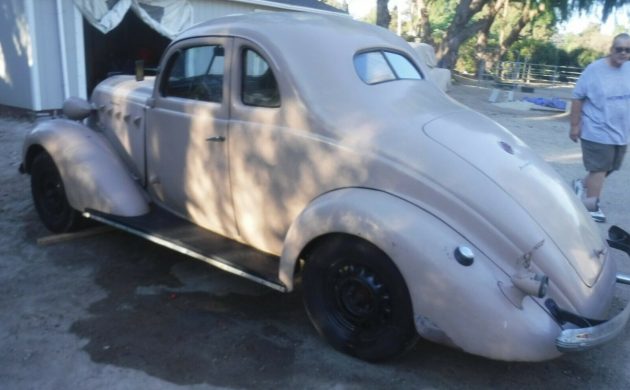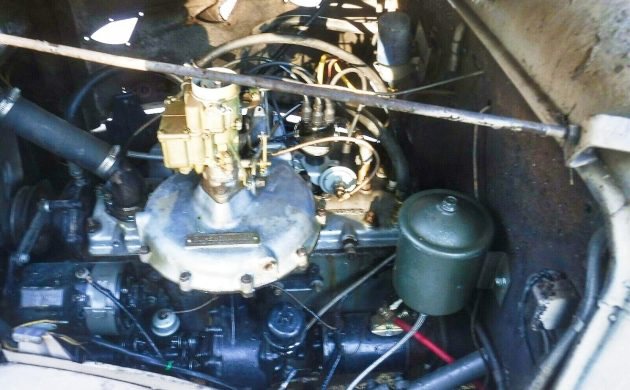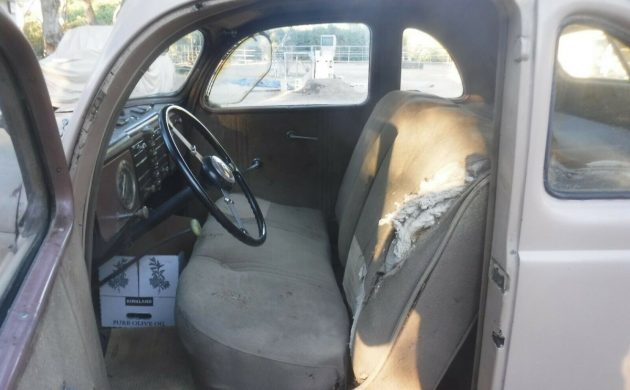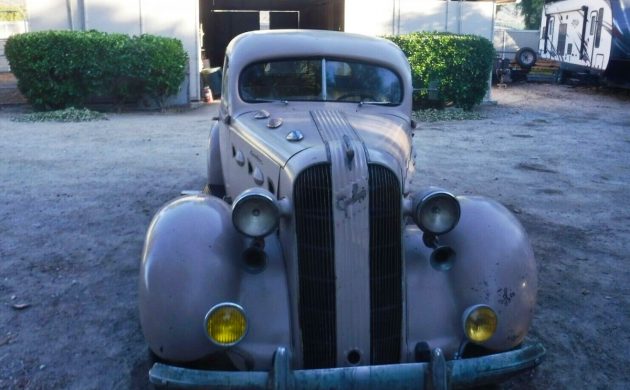Supercharged 1937 Graham Cavalier Business Coupe
The blurry and overly close photos just don’t do this 1937 Graham Cavalier Coupe justice! It’s a little rough around the edges, but it still shows the elegant styling well. Plus, it looks to be complete, is said to be rust-free, and runs. Oh, and did I mention that it’s equipped with a factory supercharger? It really is an amazing find that would be fun to have. So, if you’d love to own it, you can find it here on eBay in Simi Valley, California.
Here’s a look at the supercharged inline-six. It looks fairly clean, although it could use some detailing. The Graham/McCulloch supercharger is quite the piece of equipment, as it sits perpendicular to the crankshaft and requires a gearbox to make it all work. This setup allows a downdraft carburetor to sit on top of the supercharger and minimizes the length of the intake plumbing. According to Graham, this setup produced close to 120 horsepower, which doesn’t sound that impressive, but that was a lot in 1937 for a relatively small inline-six. The seller states that it runs well on an external fuel tank, so assume it’s going to need the tank and fuel lines serviced.
Most of the interior photos are blurry, but we do get one good view of the interior. It looks to be complete, which is a big plus, but it’s going to need work. The hard surfaces all appear to be in good condition, but it’s going to need upholstery work. It would be really interesting to know more about the car’s history and whether it has already been restored previously or if it’s fairly original. Seeing as it’s over 80 years old, it seems likely that it’s been restored at least once, but if not it held up incredibly well.
It’s hard to tell from the photos the car’s exact condition, which is a shame, but from what can be seen it looks to actually be in decent shape. Bidding has already passed $8k, so clearly there is lots of interest in it. I can’t help but wonder what the next owner has planned for it. Will it receive a full restoration or will it be turned into a wild hot rod? Given the styling, it would make for a really cool custom, plus it would be more cost-effective. That being said, you don’t find these very often and this one probably deserves to be preserved in as original condition as possible. Thoughts?
Auctions Ending Soon
 2006 Ford Mustang Saleen S281 SCBid Now4 hours$16,000
2006 Ford Mustang Saleen S281 SCBid Now4 hours$16,000
 2002 Subaru Impreza WRXBid Now3 days$333
2002 Subaru Impreza WRXBid Now3 days$333
 1975 Chevrolet Corvette ConvertibleBid Now3 days$3,000
1975 Chevrolet Corvette ConvertibleBid Now3 days$3,000
 1964 Ford F-100 Camper CustomBid Now3 days$2,000
1964 Ford F-100 Camper CustomBid Now3 days$2,000
 2006 Jeep Wrangler SportBid Now5 days$10,500
2006 Jeep Wrangler SportBid Now5 days$10,500





Comments
Was looking up pictures of restored Grahams and ran across the same car on this website.
https://car-from-uk.com/sale.php?id=68859
Looks like they want $14k+ for it. There are comments below dating back to 2014(?) Not sure what’s going on here. I swear I’ve seen this car before.
Even more scarce than the `38 Graham sedan featured yesterday! This is only the second one I’ve seen photos of ever, and I bet you can count all those that remain on one hand–minus a couple fingers! Nice lines, art-deco touches everywhere. I wonder if the mfr. hubcaps are in the car? I bet this one doesn’t last long at all. It’s too nice.
I passed on a nice brown two door turbo one with new lebonnie (spelling) interior and a rebuilt turbo charger with engine in perfect shape for 15 grand eight years back. Original paint no rust county car. It was a friend of the family etc. i was as usual with to many cars and was selling a 74 vette vert at the time with two other classic cars.
I regretted not buying from the guy later of course.
I think the main reason of leaving the shop without driving and buying was the person sadly dying of cancer kept lighting up cancer sticks while on pure oxygen ran to him to breathe.
He would stop then go again after asking to delay his fix. 💀🥺
He was a short timer and not concerned of course but I was ….👀
Well, we hear “supercharged” and wild visions of flame spewing dragsters come to mind, but the “supercharged” Graham was not all that impressive. A supercharger, unlike a turbo, needs a while to produce power, and a supercharged flathead 6 with a 1 barrel carb, I think was more of a gimmick and they became oily messes, just like non-supercharged flatheads. It was still a heavy car. Many owners probably never knew it had a supercharger. I believe, Graham became part of Dodge, you can see the resemblance but supercharging never caught on.
BTW ( and thanks to geomechs, ) a supercharger on a Detroit 2 cycle motor, the standard for drag racing today, is not a supercharger, per se, it’s a blower, to blow exhaust out of the crankcase faster, rather than compress the fuel going in. In all my trucking, I never knew that.
Wow! I did not know that. Geomechs rocks.
Graham became half of Kaiser-Frazer, then Madison Square Garden Corporation.
I had a Graham Hollywood Supercharged,and that was a QUICK car.Didn’t become part of Dodge when production ended in 1941.
Howard A, I hate to disagree but Graham never became part of Dodge. In the 1920’s the Graham brothers built bodies for Dodge trucks along with Graham Paige automobiles. Dodge thought enough of the Graham built bodies to buy the truck body division from them. The problem was that after the non compete clause in the contract, Graham went ahead and built the ‘Paige’ truck. Dodge threatened to sue and Graham stopped truck production . Graham continued to produce cars up until 1941, the last model sharing essentially a 37 Cord body with Hupp. After the war Graham sold their car producing equipment to one Joseph Frazier. He became one half of Kaiser Frazier.
Frazer.
“A supercharger, unlike a turbo, needs a while to produce power,”. Just the opposite typically. Superchargers are usually driven directly from the engine whereas a turbocharger usually relies on exhaust gases for drive and thus requires exhaust pressure to build before providing boost. I’m sure there are exceptions but those are the typical configurations.
“a supercharger on a Detroit 2 cycle motor, standard for drag racing today, is not a supercharger, per se, it’s a blower, to blow exhaust out of the crankcase faster, rather than compress the fuel going in”. That is not how something like a 6-71 blower is used on a dragster (unless there is a drag racing bus class that I am unaware of). On this Graham, I believe the shaft-driven supercharger is interposed between the 1-barrel carburetor and the intake manifold. I’m sure someone will correct me it I’m wrong.
The supercharger is between the carb & the manifold.
I’d love to be able to afford to send this to ICON and have them do the full “Derelict” treatment to it!
?
It may not be what we expect in a supercharged car but this thing is cool!! If you can count how many of these there were on one hand this one should be restored to original condition just to show people what they once were!!
I’d just leave it mainly stock, do a nice home paint job [original solid color] upholstery, put a nice disc brake setup up front & drive her around styling, don’t want 2 chop this 1 up 4 a hot rod/custom. Gotta dig that rear split window & long hood, don’t need a V8 cause most of the time u in city or traffic jam! I got a 34 ford roadster with a 51 flathead w/5spd stick & I’m in fast lane on interstate
I agree with you hundred percent breaks my heart to see beautiful cars chopped up modified! Somehow to me it seems so disrespectful!
There are those with no interest in automotive history who feel no guilt about irreversibly destroying rare survivors.
Owner clubs less often try to be “welcoming” and “tolerant” and are more apt than ever to raise a voice for historic preservation.
Excellent candidate for a rumrunner tribute.
Graham Brothers Truck most definitely became part of Dodge Brothers in 1925. Which is how the three Graham brothers became executives at Dodge Brothers.
The Graham brothers left Dodge Brothers in 1927 and acquired Paige-Detroit. Which then became Graham-Paige Motors. And it was Graham-Paige that was taken over by Joseph W. Frazer and friends in 1943.
Three Graham brothers with two Graham companies.
This 1937 Graham is not a Cavalier series, but a Supercharger. The Cavalier models did not have a supercharger – only the Supercharger series did.
The rear window is a two-piece affair – thus a Supercharger model. The Cavalier had a one-piece rear window.
Also, the supercharger was not meant for burning rubber acceleration, but to give the car enough power to cruise on highways (55-60 mph). It also got better gas mileage and Graham Supercharger models used to win the Gilmore economy runs back the late 1930’s.
My father owned a 1936 Graham Supercharger and he claimed the supercharger did give higher cruising speeds and did increase fuel economy Well, a little bit anyway. Just enough to make a noticeable difference
The Graham supercharger was a Graham designed and built unit. You can see the patent numbers on the housing. McCullough had nothing to do with it – they came later with the Kaiser unit in 1954.
To be correct, the Graham supercharger was a Roots design
Floyd Kishline developed the Graham supercharger. A brilliant engineer, he later moved to Kenosha to work for Nash and AMC. Here’s more:
https://www.findagrave.com/memorial/140124384/floyd-foster-kishline